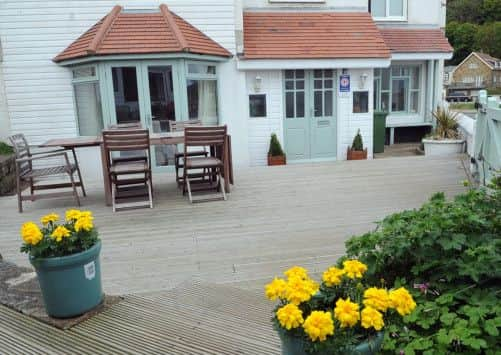Oh, we do like to be beside the seaside. So why not invest there?


Fashionable Whitby is now a year-round destination for holidaymakers and weekenders but with no shortage of accommodation, there is competition for their business.
Keen to invest on the coast, Harrogate-based investor David Copley arrived on the scene five years ago and identified two gaps in the market.
Advertisement
Hide AdAdvertisement
Hide AdOne was for luxury lets and the other was for large properties catering for extended families and groups of friends. In essence, Whitby needed more of the big and the beautiful.


David’s first project was Albany House, a Georgian townhouse in need of renovation. He gutted it and transformed it into a five star holiday home that sleeps 10 and provides him with a bolt hole by the sea.
In 2010, he bought East Row Lodge, a tired property with a small annexe, in nearby Sandsend. He spotted the potential to change the layout and create a top end let just feet from the beach.
“It needed a lot of work but the location was amazing and it had three private parking spaces, which was a real bonus. I changed the layout, re-wired, re-plumbed and re-decorated. I also added some clapboard to the front of the annexe to make it look more attractive and beach hut in style and that now houses a double bedroom and en-suite,” says David, a chartered surveyor and former estate agent, who was one half of the Beadnall Copley agency.
Advertisement
Hide AdAdvertisement
Hide AdEast Row Lodge now sleeps six and brings in £27,000 a year gross profit. It has a 75 per cent occupancy in an area where 50 per cent is the average.
“Both of the holiday lets give me double the return that I can make with standard buy-to-lets,” says David.
The secrets of his success are size and quality but he stresses that holiday letting also involves more work.
“There are lots of two bedroom lets in Whitby and Sandsend but there is increasing demand for large property so parents, children and grandparents can holiday together,” he says.
Advertisement
Hide AdAdvertisement
Hide AdTo ensure quality, he and his friends Bob and Susan Goss-Clements, who also have a holiday home in Sandsend, formed their own lettings company, Yorkshire Coastal Cottages.
“Holiday lets are more lucrative than standard lets but they need constant hands-on property management and more maintenance. High standards are crucial at the five star end of the market. I’ve put sound insulation in East Row Lodge so you can’t hear the people coughing and sneezing upstairs. Guests want great décor, high thread count sheets and good crockery and glasses,” says David.
For those who want to be hands off, he charges 18 per cent of the booking for a fully-managed service plus maintenance costs. For those thinking of investing, it also pays to have a good accountant, as holiday can have tax advantages.
Here are some tax tips from Richard Whitelock of Garbutt and Elliott:
Advertisement
Hide AdAdvertisement
Hide AdIf a holiday homes is not let and no income is generated, income tax does not come into the equation. But when the property is eventually sold there may be capital gains tax (CGT) due on any profit made on the sale of 18 and/or 28 per cent.
If the owner occupies the holiday home themselves, even if only for a few weeks per year, then the property may be treated as a second residence for CGT purposes. Depending on the circumstances and with careful planning and use of a formal CGT election, it may be possible to reduce or even eliminate any exposure to CGT on sale.
In cases where the property is let as holiday accommodation, any profit will be subject to income tax, in addition to the CGT on sale. However, properties which qualify as ‘furnished holiday lettings’ (FHLs) can benefit from more favourable treatment than ordinary buy-to-lets, as they are treated as a trade for some tax purposes.
The main advantages of FHLs are:
Some expenditure may qualify for capital allowances (on furniture, furnishings, etc.), which can often mean a greater deduction from income and lower taxable profits.
Advertisement
Hide AdAdvertisement
Hide AdCGT reliefs for traders apply to FHLs, including Entrepreneurs’ Relief which gives entitlement to a CGT rate of just 10%.
Rental profits count as relevant UK earnings for pension contribution purposes.
In order to qualify as a FHL, the property must meet all of the following criteria:
The property must be available for commercial holiday letting to the public for at least 30 weeks per year
Advertisement
Hide AdAdvertisement
Hide AdThe property must be actually let for at least 15 weeks per year
Any periods of “longer-term occupation”, more than 31 consecutive days by the same person, cannot exceed 155 days during any year.
If the property is used personally by the owner or by family or friends for no or below-market rent, while also let, there will be a requirement to apportion certain expenses between the periods of commercial and personal use, which will result in the partial disallowance of some expenses in order to arrive at the net profit for income tax purposes.
Garbutt & Elliott are chartered accountants and tax advisers with offices in Leeds and York, www.garbutt-elliott.co.uk.
Advertisement
Hide AdAdvertisement
Hide AdYorkshire Coastal Cottages, Skinner Street, Whitby, www.yorkshirecoastalcottages.co.uk
Buying to holiday let in Whitby
Whitby has some of the most expensive property on the Yorkshire coast but for those looking to invest in a holiday let, it can pay dividend.
The seaside town has a year round supply of holidaymakers and weekenders, who are attracted by its dramatic scenery, sandy beaches and its shops and restaurants.
One-bedroom flats start at £70,000, although at this price they often need modernisation. Jacksons Property Services has a one-bedroom apartment on Church Street that is an established let, sold fully furnished for £114,950: see www.jacksonspropertyservice.com.
Astin’s has a two-bedroom cottage off Church Street, for £129,950: www.astins.co.uk.